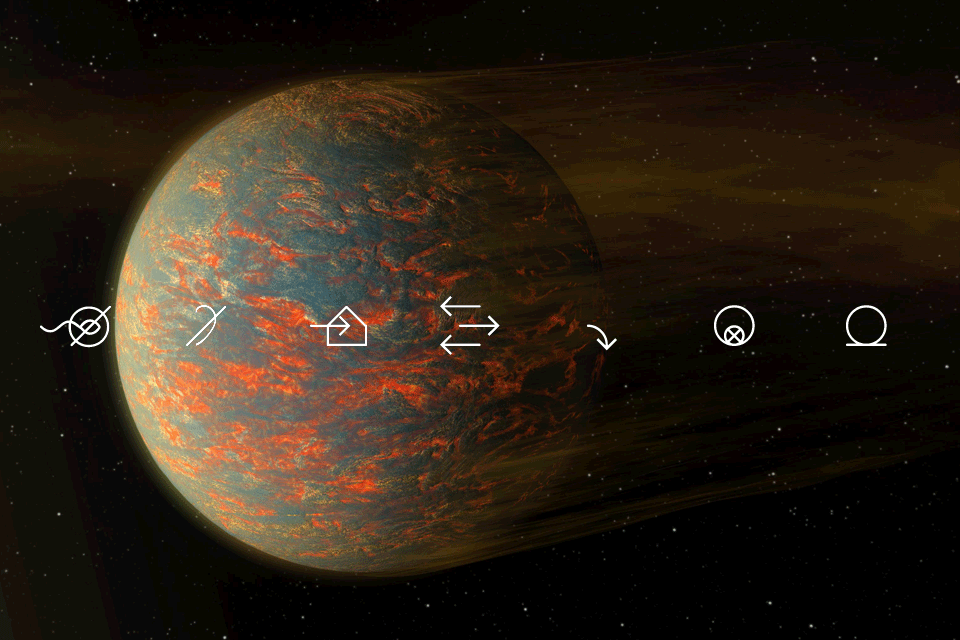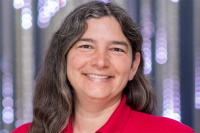Want to find extraterrestrial life? Enlist the help of the public.
NASA's Rachel Zimmerman-Brachman ’95 works with amateur astronomers to search for planets beyond our solar system where life may thrive.
 Image credit: NASA/JPL-Caltech)/Collage: Jessica Tanny
Image credit: NASA/JPL-Caltech)/Collage: Jessica Tanny A series of Blissymbols icons animate over a NASA artist's rendering of the hot, rocky exoplanet called 55 Cancri e.
NASA needs help from the public to study planets beyond our solar system. Rachel Zimmerman-Brachman ’95 is leading the recruitment effort.
In 2019, she started managing outreach activities for Exoplanet Watch, a project sponsored by NASA’s Universe of Learning effort to promote astrophysics learning and literacy.
The program asks amateur astronomers and university astronomy students to turn their telescopes toward the stars in search of planets throughout our galaxy.
The only problem is that there are billions of potential candidates. Finding just one can also be time-consuming. Thus, it falls to Zimmerman-Brachman to rally and inspire the public to aid the effort.

Rachel Zimmerman-Brachman
“Space education and outreach is all about getting other people excited about science and space,” Zimmerman-Brachman said. “I have always loved space, and I love sharing my knowledge about the planets with students and the public,” she said.
Zimmerman-Brachman was born in Canada. When she was 12, she invented the Blissymbol Printer for her seventh grade science fair project. The device enables non-speaking people to use a touchpad to select symbols that are then translated into written text and printed on paper. Blissymbols are still in use today.
After graduating from Brandeis with a degree in physics and receiving a master's degree in space studies from the International Space University in Strasbourg, France, she applied several times to become an astronaut. She worked on the Space Vision System for the International Space Station at the Canadian Space Agency near Montreal, Quebec.
She then moved to California to work as a public engagement specialist at NASA’s Jet Propulsion Laboratory (JPL) in Pasadena, California, where she spent 11 years working on the Cassini mission to Saturn. Zimmerman-Brachman now spends much of her time coordinating the Exoplanet Watch citizen science project.
Exoplanets, short for extrasolar planets, are planets beyond our solar system. Because they orbit other stars, they are much too far away to send space probes to explore directly.
Scientists are especially interested in finding planets that could potentially sustain life. The most likely candidates are planets orbiting their stars at a distance that makes the temperature range on the planet suitable for liquid water to exist.
To date, scientists have identified and confirmed the existence of over 4,400 exoplanets, but this number is expected to be in the tens of thousands within the decade.
“When I was a student at Brandeis, exoplanets hadn’t been discovered yet. It was only a few months after my graduation in 1995 that the first exoplanet was discovered. Once we learned how to look for them, astronomers started finding exoplanets almost everywhere,” Zimmerman-Brachman said.
JPL’s astronomers primarily use the planetary transit method to detect exoplanets. Using space-based, Earth-orbiting telescopes like Kepler and Transiting Exoplanet Survey Satellite (TESS), they monitor the dimming of a star’s light that occurs when an exoplanet passes in front of it.
Scientists compete for time to use these telescopes. Planetary transits can take several hours.
By including amateur space enthusiasts across the world in the search for exoplanets, JPL can effectively monitor many more planetary transits. These citizen scientists help to observe transiting exoplanets and collect data about the precise timing of when the transit takes place.
Zimmerman-Brachman doesn’t know whether we will ever find extraterrestrial life, but if we do, she said it may take the help of the public to find it.
"We design these projects with the public in mind, so that anyone can contribute to a better understanding of our universe,” she said.
Categories: Alumni





